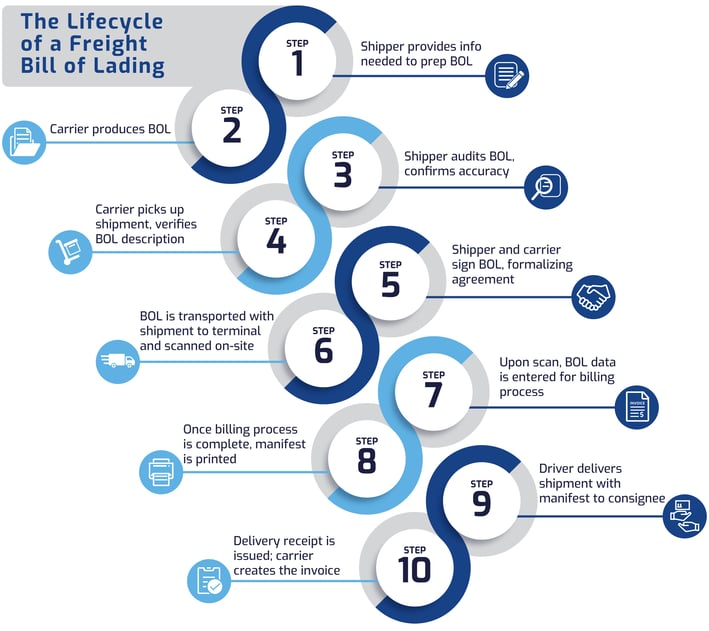The Lifecycle of a Freight Bill of Lading & Focus Areas for Improvement

A bill of lading (BOL) serves as a ledger of goods transferred from one entity to another, as well as a legal contract between the shipper and a carrier. One document among many used in the supply chain, a BOL is perhaps the most important, as it follows the cargo from the shipper to its final recipient.
As the BOL is used to document important details of the transaction, it serves as proof of shipment for the carrier. If incomplete or incorrect, a BOL can create problems for both the shipper and the carrier, including costly and time-consuming shipment delays.
To help avoid those pitfalls, we sat down with billing solution experts at DDC to better understand the full lifecycle of the bill of lading, and which key areas of its journey are ripe for improvement.
The Freight Bill of Lading Lifecycle
Chances are you’re familiar with the bill of lading lifecycle, but it’s worth reviewing in brief:

Traditionally, this process involves handing off paper documents between parties for input before they are signed, but that leaves a lot of room for human error. When a field is incorrectly inputted, even accidentally, labor and time are added to the BOL lifecycle that leads to unnecessary delays.
How BOLs are Processed
Processing and managing BOLs is a labor- and resource-intensive process. Even carriers who are leveraging software to process their BOLs in-house often find that it falls short of their expectations doesn’t have the features they need or is too costly to maintain.
While some carriers may process their BOLs in-house, many choose to outsource bill processing so they can utilize their in-house staff to focus on other tasks.
Quality Metrics Matter
Sometimes shippers accidentally input incorrect data on the BOL or leave out critical information. If the error isn’t caught early, the results can be costly.
When information is incorrect or left out, a simple oversight can cause delays in the timely delivery of shipments, and result in delayed payments. Some of the information that is most commonly forgotten or inputted incorrectly includes:
-
Consignee
-
Bill-to or Third Party
-
Freight Term (prepaid or collect)
-
Number of Pieces and Weight
-
NMFC or class
-
Accessorial Codes
-
PO or BL or Reference Number
Often, a shipper won’t know the proper Class and NMFC codes to use, so they leave it blank on the BOL. In other instances, one party doesn’t know the correct freight payment terms or important information on hazmats for hazardous goods. Too often, the result is freight that is delayed or disputed later on.
Key Areas of the BOL Lifecycle Ripe for Improvement
The amount of time and labor that goes into verifying and processing a BOL can impact your bottom line, so it’s no surprise that there are serious advantages to efficiently created BOLs:
Data Entry & Quality Assurance
BOLs must be correctly filled out, then signed and dated to produce a record of when the cargo was loaded and its conditions. A BOL that is post-dated can lead to serious consequences, including exposure to claims from cargo interests.
BOLs are commonly used in litigation. When a BOL doesn’t reflect the conditions that freight is shipped under, it can put a whole host of claims into action — and open up a number of potential avenues for profit loss (and headache) that are best avoided outright. Plus, when the BOL is inaccurate in this way, insurance coverage such as Protection and Indemnity (P&I) may be revoked.
Turnaround & Processing Time
A faster, more accurate BOL is one that gives businesses the advantage of faster turnaround times.
Shipping companies that build out capacity to quickly process bills of lading get a head start over competitors that don’t. Investing in BOL processing gives large companies with a more dynamic and responsive supply chain, which is increasingly a competitive advantage over smaller competitors.
Customer Visibility
Customers are demanding unprecedented levels of transparency. These changing expectations make managing BOLs using the old clipboard-and-pen routine increasingly difficult. In order to meet consumer expectations, shippers and carriers need to make cargo as interconnected as any other network.
If you exceed their expectations, customers are often willing to pay extra for the better quality service you provide. Nowhere is this more true than in the supply chain, where there’s always a competitor looking to undercut your price or provide more accurate tracking. An experienced technology partner that can improve your freight tracking while streamlining your paperwork is an indispensable asset.
Incorporating Innovation
Enhancing your BOL process with a third-party expert can provide big benefits for your organization.
Fully and semi-automated programs eliminate much of the need for in-person labor, which limits the opportunity for human error and improves data entry speed. It can also improve the overall accuracy of the BOL entry process. And, by handing off your BOL processing to a third-party team, you create time for your in-house experts to focus on other revenue-creating improvements to your process.
In addition, automating your billing process powers advanced standardization that allows for quality metrics to be met. A BPO provider can also help elevate your customer service, improve visibility along the supply chain, and much more.
Choosing the right partner is key to success. A trusted expert like DDC can help streamline your billing lifecycle, and provide valuable automation and processing for other key processes like rate auditing, POD processing, and more. We can even help power up your sales and manage your customer lifecycle.
Connect with Us
DDC FPO has over 15 years of delivering success to the freight and logistics industry. Ready to explore how we can help to streamline your freight billing process?
How Can We Help You?
Get in touch to learn how we can support your success.
Get Started
